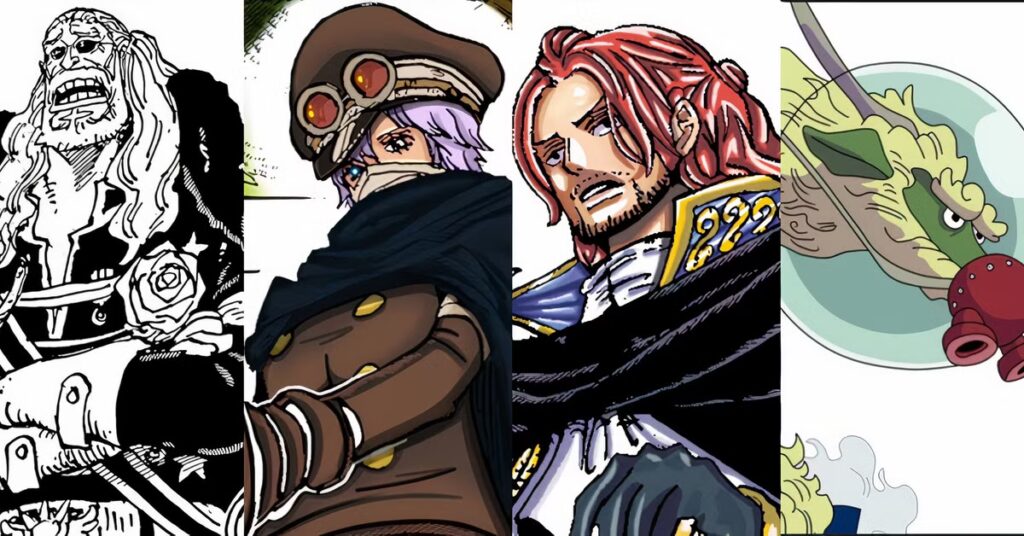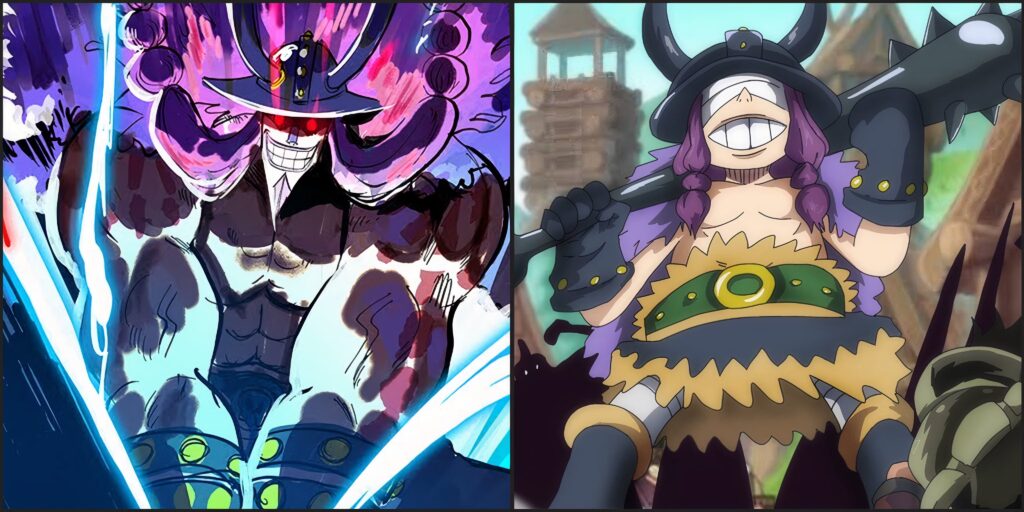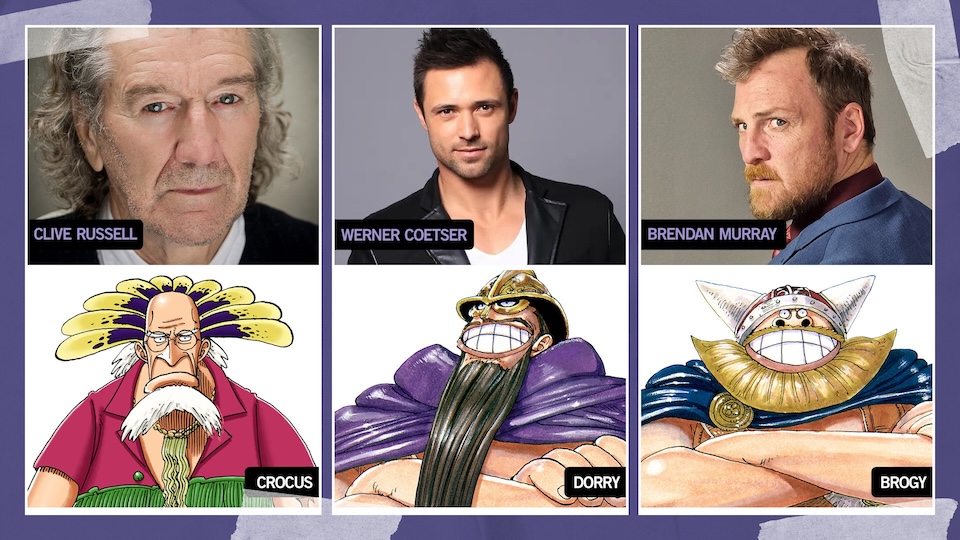The Palette War: When Color Becomes Controversy
One Piece fans have never been shy about voicing opinions. They’ll debate power scaling for hours, argue about bounties like it’s a stock market, and dissect a single panel as if it were scripture. But nothing quite exposes the emotional fault lines of the fandom like a color reveal.

When the official designs for the Holy Knights dropped, it wasn’t just a release; it was a ripple through the collective bloodstream of the internet. These shadowy figures, long teased in monochrome mystique, had finally been given shape, hue, and life. The result? A palette war.
Some praised Eiichiro Oda’s new artistic choices: the saturated reds, metallic sheens, the high-contrast tones that feel ripped from a mythological fresco. Others felt betrayed, as if mystery itself had been colorized and domesticated. “Why make gods ordinary?” one fan lamented on Reddit. “The Holy Knights were supposed to feel untouchable, not like a cosplay convention lineup.”
That may sound harsh, but it points to something deeper: the emotional ownership of a shared world.
For years, the Holy Knights existed only in whispers, powerful figures under Imu’s rule, glimpsed but never defined. Fans projected their own ideas onto the void: divine arbiters, celestial assassins, or embodiments of the Void Century’s sins. When Oda finally unveiled them, the fandom didn’t just see characters; they saw a mirror that didn’t match their reflection.
The Artist and the Audience: Who Owns the Mystery?
Here’s the paradox of modern fandom: the closer a story gets to its end, the less control its creator seems to have over its interpretation. Oda may hold the pen, but millions hold the screen, and in that gap between ink and imagination, ownership blurs.
One Piece isn’t just a manga anymore; it’s a generational artifact. It’s been passed through classrooms, coffee shops, comment threads, and Discord servers. People don’t consume it; they inhabit it. So when Oda’s new color schemes appear “off,” it’s not just about taste. It’s about identity.
Take the Knight designs that emphasize contrast: the regal crimson cloaks against pale armor, the play of shadow on divine insignias. They evoke nobility, but also mortality—maybe too much of it. Fans who expected otherworldly beings instead saw something grounded, human, even vulnerable. That might be Oda’s point. But it’s not everyone’s preference.

Some argue that Oda’s direction signals a shift in his storytelling tone. The final saga, after all, isn’t just about power; it’s about the collapse of myth. The gods of the world are being revealed as fallible, corrupt, or broken. Maybe the Holy Knights were never meant to remain silhouettes. Maybe the act of coloring them in was the point: a metaphor for truth replacing faith.
But that nuance is hard to discuss in a fandom conditioned by immediacy. The louder reactions—“ruined design!” “masterpiece art!”—drown out the middle ground. And yet, that middle is where Oda has always lived: between beauty and absurdity, reverence and ridicule, the sacred and the silly.
From Panels to Pixels: Netflix’s Expanding Seas
Meanwhile, on the other side of the One Piece universe, another reveal stirred the waters, this time in live action.
Netflix has released the first look at Dorry and Brogy, the towering giants from the Little Garden arc, confirming that Season 2 will officially sail into the Grand Line. The photos alone tell a story: the massive horns, the braided beards, the Viking-inspired armor gleaming under cinematic light. It’s not just a nostalgic callback. It’s a statement—this adaptation is ready to grow up.
The East Blue saga was intimate: personal stakes, small sets, character-driven storytelling. Little Garden? It’s prehistoric chaos. A land where time froze, where two warriors fought for a century over honor, and where Luffy learned that simplicity and glory often live side by side.
The Netflix stills capture that atmosphere: lush jungles, towering bones, skies heavy with myth. The color grading leans toward earthy realism—ochres, greens, and smoke—a deliberate move away from the cartoon brightness of Season 1. It’s less “pirate playground” and more “mythic wilderness.” You can almost feel the humidity.
And perhaps that’s where the live-action project will truly define itself, not by perfect replication but by reinterpretation through texture.
Giants of Myth, Men of Flesh
Dorry and Brogy aren’t just characters; they’re walking contradictions. Titans locked in endless battle, too proud to yield, too loyal to their own code to notice the world moving on. They embody the tragic poetry of Oda’s universe, where laughter and violence coexist, where giants cry and fools become legends.
Bringing that to live action isn’t easy. Too much realism, and you lose their mythic energy. Too much stylization, and you get a theme park fight scene. Netflix’s challenge is balance—the same balance Oda constantly chases in manga form.
In the stills, there’s a subtle reverence. The way light filters through fog, catching the curve of a horn. The proportion of human actors against the towering figures. It’s not just spectacle; it’s awe.
And that’s something One Piece has always thrived on: the awe of scale. Mountains that move. Islands on elephants. Giants who laugh in eternity. If the live-action adaptation can capture that awe without losing the intimacy of emotion, it might just silence even the harshest skeptics.
The World Expands, and So Does the Risk
Here’s the throughline between both controversies—the Holy Knights’ colors and Netflix’s giants: risk.
Oda risks redefining icons. Netflix risks reinterpreting legend. Both risk alienating fans. But both are essential acts of growth.
We often say we want “innovation,” but what we really want is evolution that feels familiar. When change strays too far from nostalgia, it becomes heresy. When it stays too safe, it feels like stagnation. The creators of One Piece, in all its forms, are walking that razor’s edge.
The Holy Knights controversy might feel trivial—color palettes, armor detailing, lighting tone—but it reveals something profound about storytelling in the 21st century: every aesthetic decision is a referendum. Fans will litigate every frame, tweet every shade, and turn creative ambiguity into social currency.
Yet within that noise lies passion—the same passion that built the empire of One Piece itself. The same fire that made people wait decades to see a single line of dialogue pay off. The same energy that fuels artists, animators, and yes, even streamers, to take risks.
The Maturity of a Myth
If you zoom out, you can feel something shifting. One Piece, across manga, anime, and live action, is moving from adventure to legacy. It’s no longer just a story about the sea; it’s a myth being recorded in real time.
When the manga first began in 1997, Oda’s lines were loose and playful, his tone more comedic than cosmic. Now, the Holy Knights’ designs look sculpted in marble. His storyboards carry gravitas, his pacing like a war drum. Every design choice, every splash of color, feels like an echo of finality.
So when fans debate whether the Holy Knights should have looked “darker” or “more divine,” what they’re really reacting to is this tonal evolution. Oda isn’t just drawing pirates anymore. He’s illustrating theology—the collapse of gods, the rise of man, and the price of freedom.
Meanwhile, Netflix’s expansion mirrors that same transition. Season 1 captured childhood wonder. Season 2 looks poised to tackle mythic adolescence, where characters confront the vastness of the world and their smallness within it.
Little Garden isn’t about treasure. It’s about time. It’s about fighting because you must, not because you win. It’s the perfect mirror to where One Piece stands now: too far to turn back, too meaningful to stop.
Why the Fandom Reacts So Fiercely
Let’s be honest, One Piece fans are emotionally intense. They’ve invested not just time, but identity. Many have grown up with Luffy. Some even measure their lives in arcs: “I started high school during Marineford,” “I graduated around Dressrosa,” “I got married in Wano.”
So when something as simple as a color palette changes, it’s not cosmetic. It’s existential. The Holy Knights aren’t just characters; they’re milestones in a shared mythos. When they’re revealed differently than imagined, it’s like someone rearranged your childhood bedroom—familiar, but disorienting.
Netflix’s adaptation faces the same phenomenon. Every casting choice, every lighting tone, every sword swing becomes a test: “Does this feel like One Piece?”
But feeling is subjective. And that’s the double bind of success—the bigger the world becomes, the more personal everyone’s version of it feels.
The Art of Letting Go
Here’s an uncomfortable truth: no version of One Piece, manga, anime, or live action, will ever perfectly align with fan memory. That’s not failure; it’s art doing its job.
Oda’s color decisions remind us that creators evolve even when audiences resist. Netflix’s giants remind us that scale can be reimagined without sacrilege. Together, they represent something many fandoms fear but secretly need: renewal.
Art that never risks disapproval becomes decoration. Stories that never upset their fans die quietly under the weight of nostalgia.
Maybe the Holy Knights’ bright colors are meant to irritate. Maybe the live-action’s gritty palette is meant to unsettle. Maybe discomfort is the point, the narrative equivalent of shaking us awake before the final voyage.
The Final Sea
There’s something poetic about how these two stories, the coloring of gods and the rendering of giants, surfaced at the same time.
One looks inward: how divine figures are reimagined through tone and texture. The other looks outward: how human ambition tries to recreate the impossible on screen. Both ask the same question: what happens when imagination becomes tangible?
Oda’s world is closing in on its final act. Netflix’s version is just setting sail. Between them lies a conversation about authorship, ownership, and adaptation—a conversation that defines modern storytelling.
Because One Piece isn’t just a series anymore. It’s a living myth, reshaped by every eye that looks at it.
Some fans will rage about color tones. Others will cry when they see Dorry and Brogy brought to life. And somewhere in the middle, a truth will linger: the world Oda built is strong enough to survive disagreement, adaptation, and reinvention.
That’s what makes it a legend—not that everyone loves it, but that everyone cares enough to argue.
Epilogue: The Cost of Caring
Art that inspires indifference is forgettable. Art that divides is alive.
Oda’s Holy Knights may not please every fan, but they’ve reignited the discourse that keeps One Piece vibrant. Netflix’s giants may not look exactly as imagined, but they prove that someone, somewhere, still believes this story deserves to be retold—not as nostalgia, but as renewal.
Both are acts of faith: one in pen, one in camera. Both remind us that this isn’t the end of the Grand Line; it’s just a new current.
And if the seas ahead look wilder, brighter, or stranger than we expect, maybe that’s the whole point. After all, it’s not adventure if it stays familiar.

